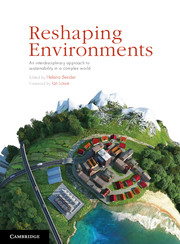Book contents
- Frontmatter
- Contents
- Contributors
- Acknowledgements
- Introduction Reshaping environments – an opportunity for envisioning the future
- Part 1 Cases
- 1 Costa Rica’s dry north-west
- 2 Reshaping land transport in Singapore
- 3 Evaluating different ways of managing forested landscapes
- 4 Changing the landscape management paradigm with farmers
- 5 Meeting development goals without blowing your carbon budget
- 6 The EGLE has landed
- 7 Reshaping the Murray-Darling Basin, Australia
- 8 Burning questions
- Part 2 Skills
- Part 3 Theory
- Index
- Plate Section
- References
4 - Changing the landscape management paradigm with farmers
A story of community-based resource management in the ‘Heartbreak Hills’, Victoria, Australia
from Part 1 - Cases
Published online by Cambridge University Press: 05 February 2013
- Frontmatter
- Contents
- Contributors
- Acknowledgements
- Introduction Reshaping environments – an opportunity for envisioning the future
- Part 1 Cases
- 1 Costa Rica’s dry north-west
- 2 Reshaping land transport in Singapore
- 3 Evaluating different ways of managing forested landscapes
- 4 Changing the landscape management paradigm with farmers
- 5 Meeting development goals without blowing your carbon budget
- 6 The EGLE has landed
- 7 Reshaping the Murray-Darling Basin, Australia
- 8 Burning questions
- Part 2 Skills
- Part 3 Theory
- Index
- Plate Section
- References
Summary
Introduction
This case study describes a community-based natural resource management (CBNRM) program for conservation on private agricultural land. The farmers and government agencies in this study are associated with the Victorian Landcare program, now Landcare (LC); and in particular with the formation of Farmcare groups in the Strzelecki Ranges of Victoria, an area known historically as ‘the Heartbreak Hills’. CBNRM programs create a platform for farmers and their government support agencies to converge around changing landscape management outcomes. The program began in this cleared, highly eroded, steep hill country, located approximately two hours from the city of Melbourne, in 1992 and is ongoing. This chapter reflects on LC’s role as a CBNRM program, focusing on its ability to provide an umbrella organisation for the negotiation of ideas about sustainability in this landscape. In this way the LC program is positioned between and becomes a part of the negotiation of land management changes that are driven by the interpretation of science, technology and community local knowledge. This chapter describes how local people linked their individual property scales to a regional catchment scale, utilising ideas from systems thinking. By re-imagining their landscapes as connected to the wider landscapes around them, they came to change their management objectives. Ultimately this created different conservation and agricultural norms and values and changed their understanding of what it means to be ‘sustainable’.
What is Landcare?
Landcare in Victoria began in 1986 with an alliance between the Victorian Farmers Federation (VFF) and the Victorian Department of Environment and Conservation (VDEC). These two agencies had very different programs. The VFF was focused on maximising production and markets for farmers’ products; and the Department was concerned with conservation values associated with revegetation, stream management, weed control, and increasing biodiversity associated with indigenous plant and animal species. Their decision to work together was heralded as a ‘win-win’ situation for farmers and conservationists, providing an opportunity to jointly define and implement a vision for sustainable landscapes in the state. In 1990 this model was taken up at a national level with a partnership between the National Farmers Federation (NFF) and the Australian Conservation Foundation (ACF) to promote Landcare nationally. LC is intended to promote local identification of important landscape management issues, to seek local solutions and to involve local communities in partnership with the responsible agencies to improve natural resource management (NRM) decision-making for sustainable landscape outcomes.
- Type
- Chapter
- Information
- Reshaping EnvironmentsAn Interdisciplinary Approach to Sustainability in a Complex World, pp. 82 - 113Publisher: Cambridge University PressPrint publication year: 2012



